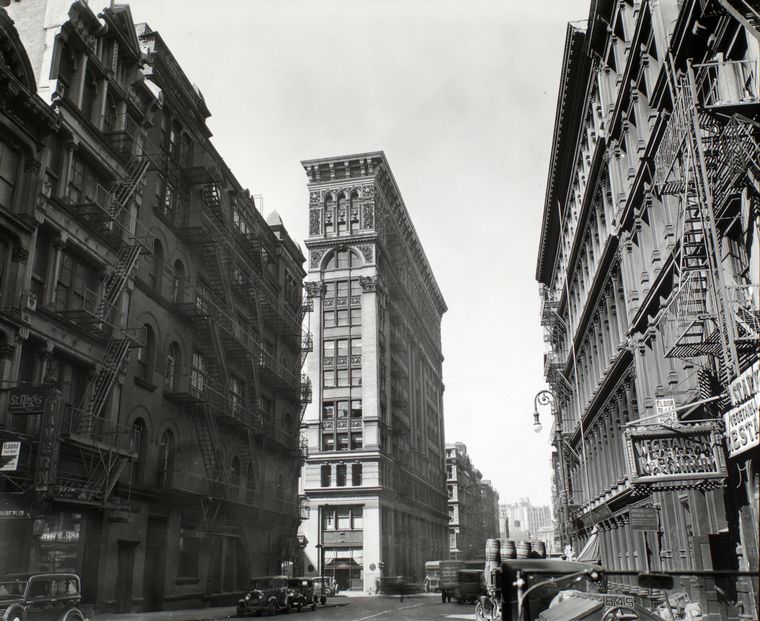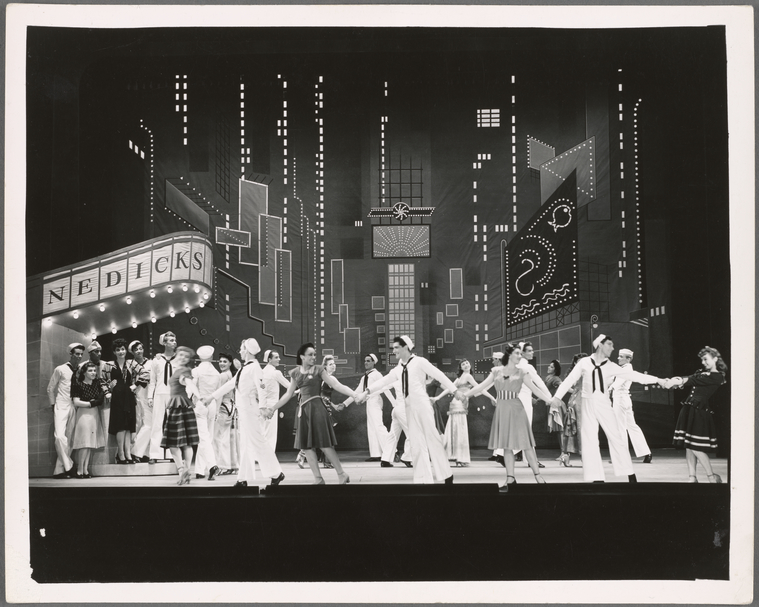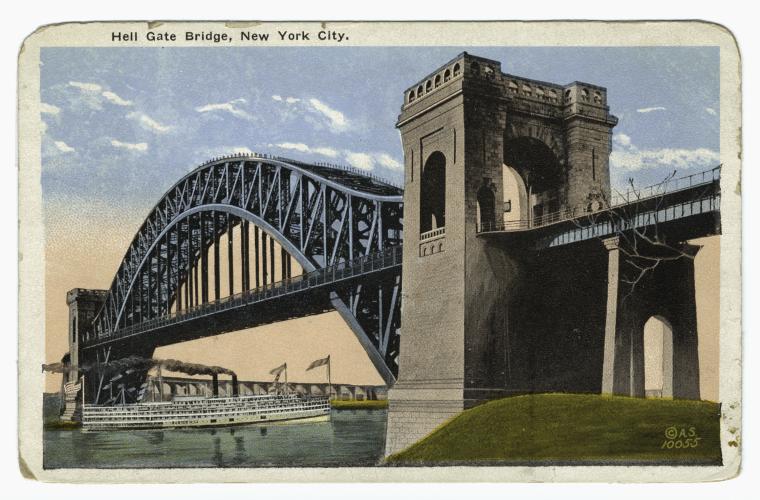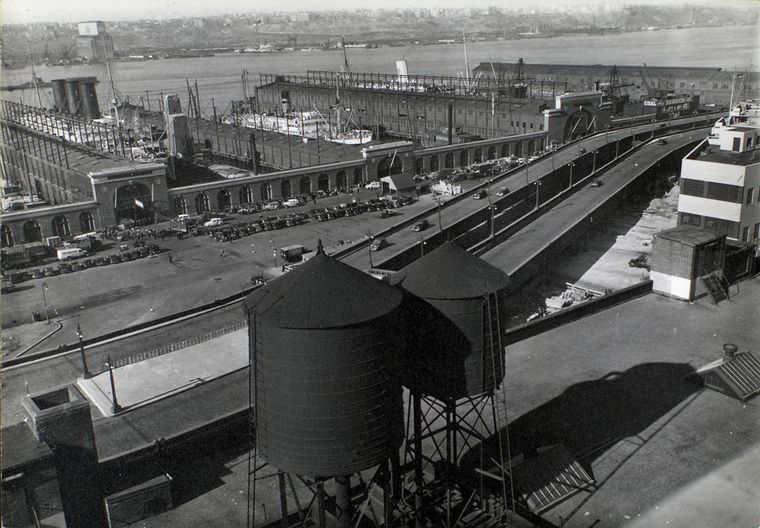NYC Neighborhoods
A Helluva Town: The Origins of New York’s Hellish Place Names
"New York, New York, a helluva town. The Bronx is up but the Battery's down." —On the Town
With at least three "Hell" based place names within its boundaries—Hell Gate, Hell's Kitchen, and Hell's Hundred Acres—New York City is indeed a helluva town. But in spite of name and reputation, these places are now far from infernal.
Hell Gate is the oldest place name of these three. Dating back to New Amsterdam's Dutch colonial period, Hell Gate is a corruption of the Dutch name "Hellegat" which meant "hell channel." It refers to the narrow and treacherous strait of water separating Astoria, Queens, from Ward's Island, and connecting the Long Island Sound to the East River.
The Encyclopedia of New York City tells us that Hell Gate earned its name from sailors navigating the shallow channel's strong currents and rocky reef. Hundreds of ships have sunk into Hell Gate, including the British ship Hussar, which in 1780 shipwrecked whilst carrying a significant amount of silver and gold. Its treasure is still sought by divers.
The Army Corps of Engineers widened and deepened the channel in the nineteenth century using "the greatest quantity of explosives ever attempted in a single operation." The feat drew over fifty thousand spectators to the shores of the East River to watch the geyser-like spectacle caused by the detonation.
Spanning the waterway is the Hell Gate Bridge, a picturesque railroad bridge which links New York City to New England. Although some places in the city take their name from Hell Gate, such as the Hell Gate Station Post Office, Hell Gate officially refers to the waterway and its bridge, not to a neighborhood or other piece of land.
Hell's Kitchen
Bounded by Eighth Avenue to the east, the Hudson River to the west, 59th Street to the north, and 30th Street to the south is a neighborhood that some might say is "Midtown West." A taxi map will tell you that it is called "Clinton," but almost any New Yorker will still refer to this place as Hell's Kitchen.
The Encyclopedia of New York City opens its entry for Hell's Kitchen by referring to it as an "obsolete term," though we certainly still hear it in pop culture. The area acquired this name sometime in the mid-nineteenth century, either from a neighborhood gang or the local police. By the time of the American Civil War, Hell's Kitchen was known as violent, impoverished slum. It has been home to several different ethnic groups over the years: Irish, Scots, Germans, African Americans, Greeks, Eastern Europeans, Puerto Ricans, and others. Gangs such as the Gophers and the Westies have domineered there. In fact, it was a gang-related murder in 1959 that prompted local officials to begin calling the neighborhood "Clinton" in efforts to improve its image. The name was derived from De Witt Clinton Park, located at Eleventh Avenue between 52nd and 54th Streets.
Nonetheless, the Hell's Kitchen moniker persists in common parlance. Its mean past is remembered in films such as West Side Story, countless murder-mystery books, and invoked in chef Gordon Ramsay's books and television programs. Currently the neighborhood is home to a diverse and rich restaurant scene along Ninth Avenue, Comedy Central's Daily Show Studios, CBS Broadcast Center, the Hearst Tower, and the Intrepid Sea-Air-Space Museum. This abundant array of cultural and commercial establishments affirms that tourists are definitely not afraid to wander there. Whether or not they call it "Clinton," "Midtown West," or "Hell's Kitchen," only taxi drivers know for sure.
 Hell's Hundred Acres
Hell's Hundred AcresUnlike the previous two areas, the nickname Hell's Hundred Acres was actually born of fire. Following a series of terrible fires in the environs, some of which cost the lives of several firefighters, Fire Commissioner Edward Cavanagh coined the name to express his feelings about the major fire hazards and deteriorated conditions he considered perilous.
Today the neighborhood is remembered for its stylish dwellings and innovative art scene—and it is called SoHo. You can follow the neighborhood's transition in the New York Times Historical database by searching the term "Hell's Hundred Acres." If you read the resulting articles in chronological order, you'll see the stories shift from reports of fire violations, warnings from Cavanagh, and descriptions of hazards, to stories of artists organizing, urban renewal, and eventually creation of the term "SoHo." In late 1962, the City Planning Commission called for a "South Houston Street survey," a study that surprisingly showed the neighborhood to be economically thriving despite its run-down reputation. Subsequent articles use the term "South Houston Industrial Area," and by 1970, "SoHo." Unlike "Hell's Kitchen", the moniker "Hell's Hundred Acres" practically disappears.
Read E-Books with SimplyE
 With your library card, it's easier than ever to choose from more than 300,000 e-books on SimplyE, The New York Public Library's free e-reader app. Gain access to digital resources for all ages, including e-books, audiobooks, databases, and more.
With your library card, it's easier than ever to choose from more than 300,000 e-books on SimplyE, The New York Public Library's free e-reader app. Gain access to digital resources for all ages, including e-books, audiobooks, databases, and more.
If you don’t have an NYPL library card, New York State residents can apply for a digital card online or through SimplyE (available on the App Store or Google Play).
Need more help? Read our guide to using SimplyE.



Comments
The 4th
Submitted by Trevor (not verified) on April 22, 2011 - 3:59pm
I'm not familiar with that
Submitted by Carmen Nigro on April 22, 2011 - 5:15pm
"Hell Hill"
Submitted by Paul (not verified) on June 28, 2011 - 11:31am
Hell Hill
Submitted by Anonymous (not verified) on October 8, 2012 - 10:03pm
Addendum
Submitted by Trevor (not verified) on April 22, 2011 - 4:22pm
Jesse da Body the "rapper"
Submitted by Stacy "PittBull" (not verified) on April 21, 2015 - 1:10am
Great Post!
Submitted by Shawn Donohue on April 26, 2011 - 10:36am
Thanks Shawn! I agree,
Submitted by Carmen Nigro (not verified) on April 27, 2011 - 11:58am
Very interesting and
Submitted by Anonymous (not verified) on October 5, 2011 - 1:19pm
Hell Gate
Submitted by Donatella (not verified) on October 12, 2011 - 2:58pm
NY City's Hellish Places
Submitted by Anonymous (not verified) on October 13, 2011 - 9:25am
Hell's Kitchen - name origin
Submitted by Barbara (not verified) on October 31, 2011 - 12:33pm
West Chelsea Referred to as Hell's Kitchen in 1943 Mrkt Analysis
Submitted by David (not verified) on June 19, 2012 - 3:20pm
ALLENBOYS
Submitted by Carlito vega (not verified) on September 25, 2013 - 1:26pm
Comment to Addendum
Submitted by Stacy "pittbull... (not verified) on April 21, 2015 - 1:47am